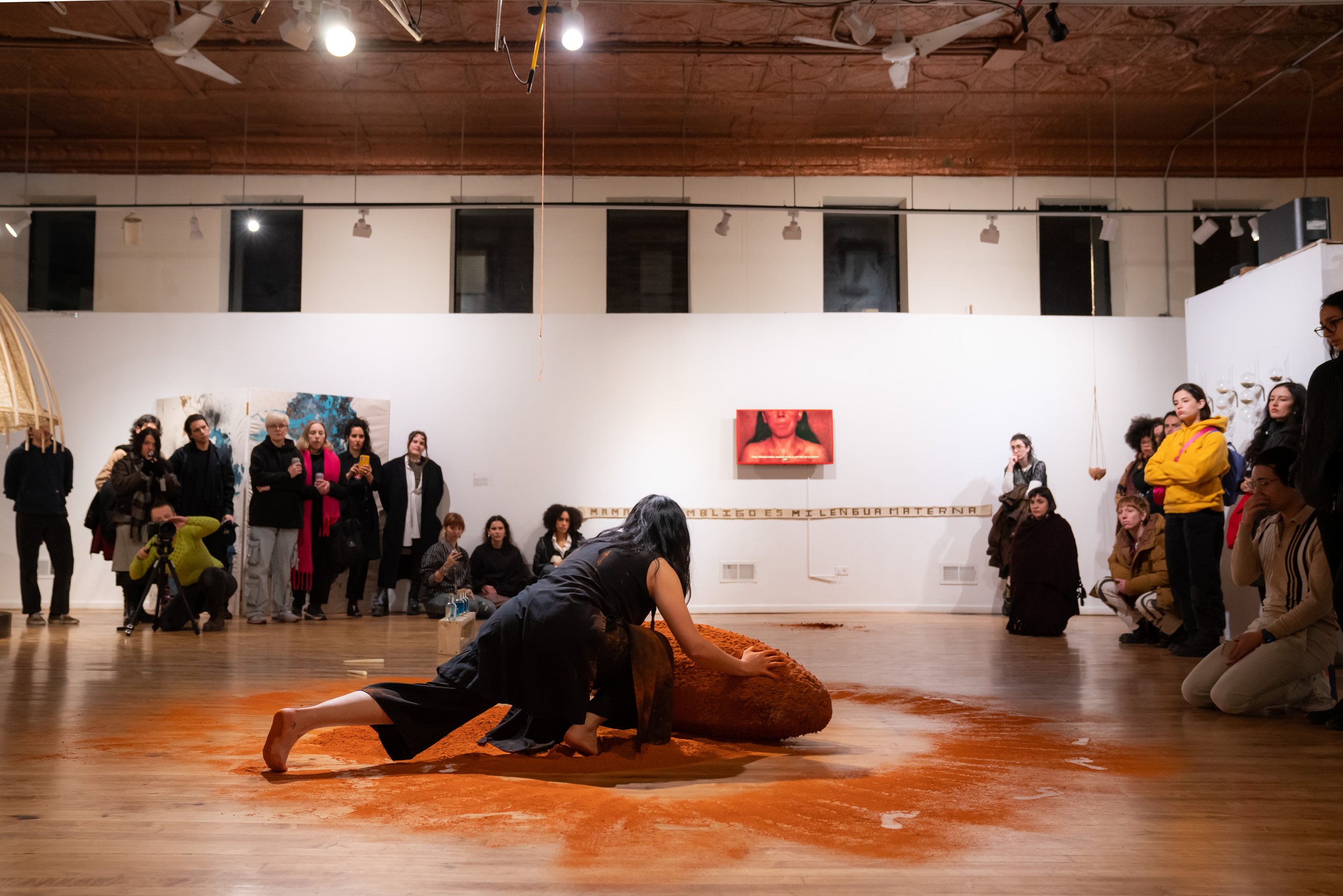
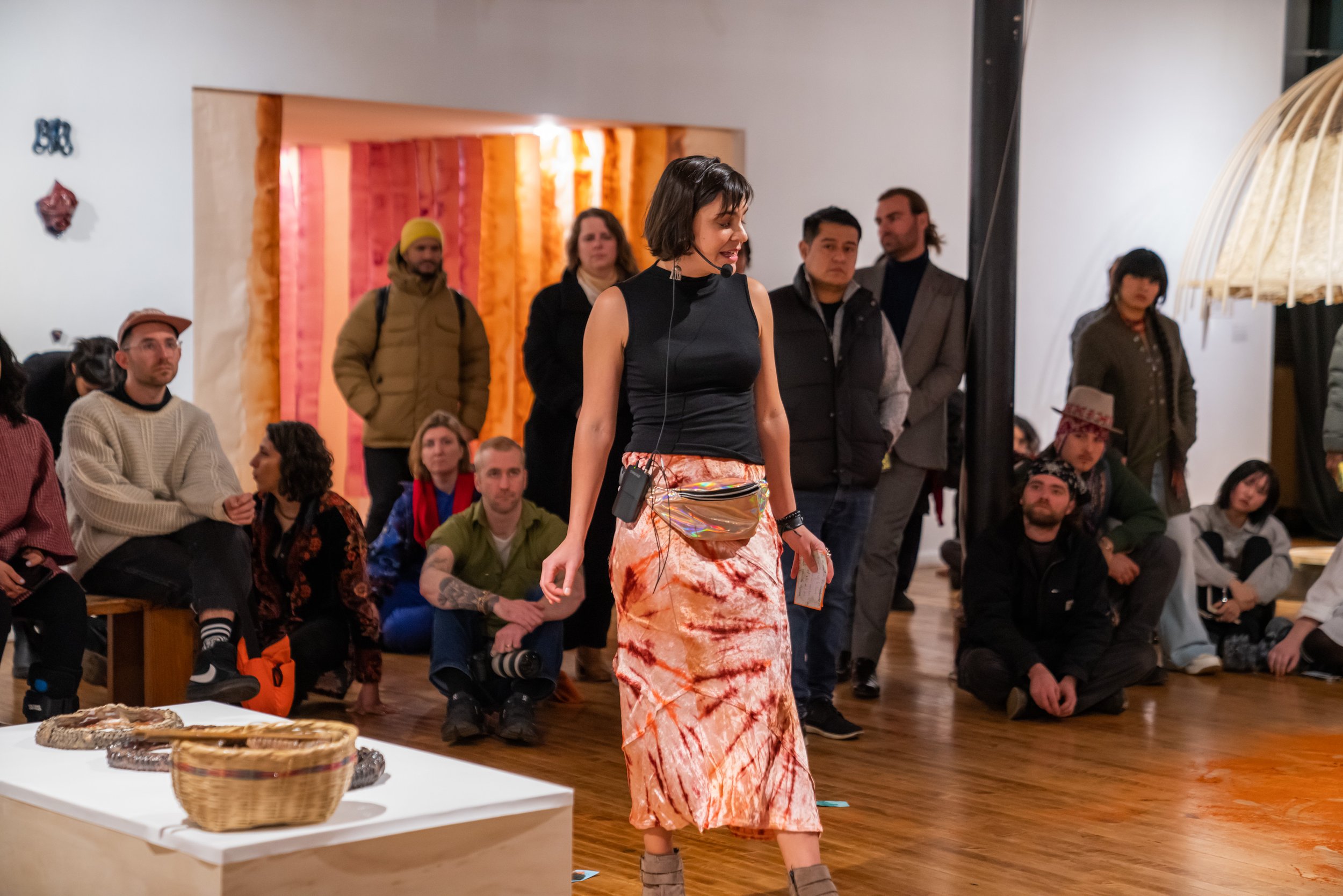
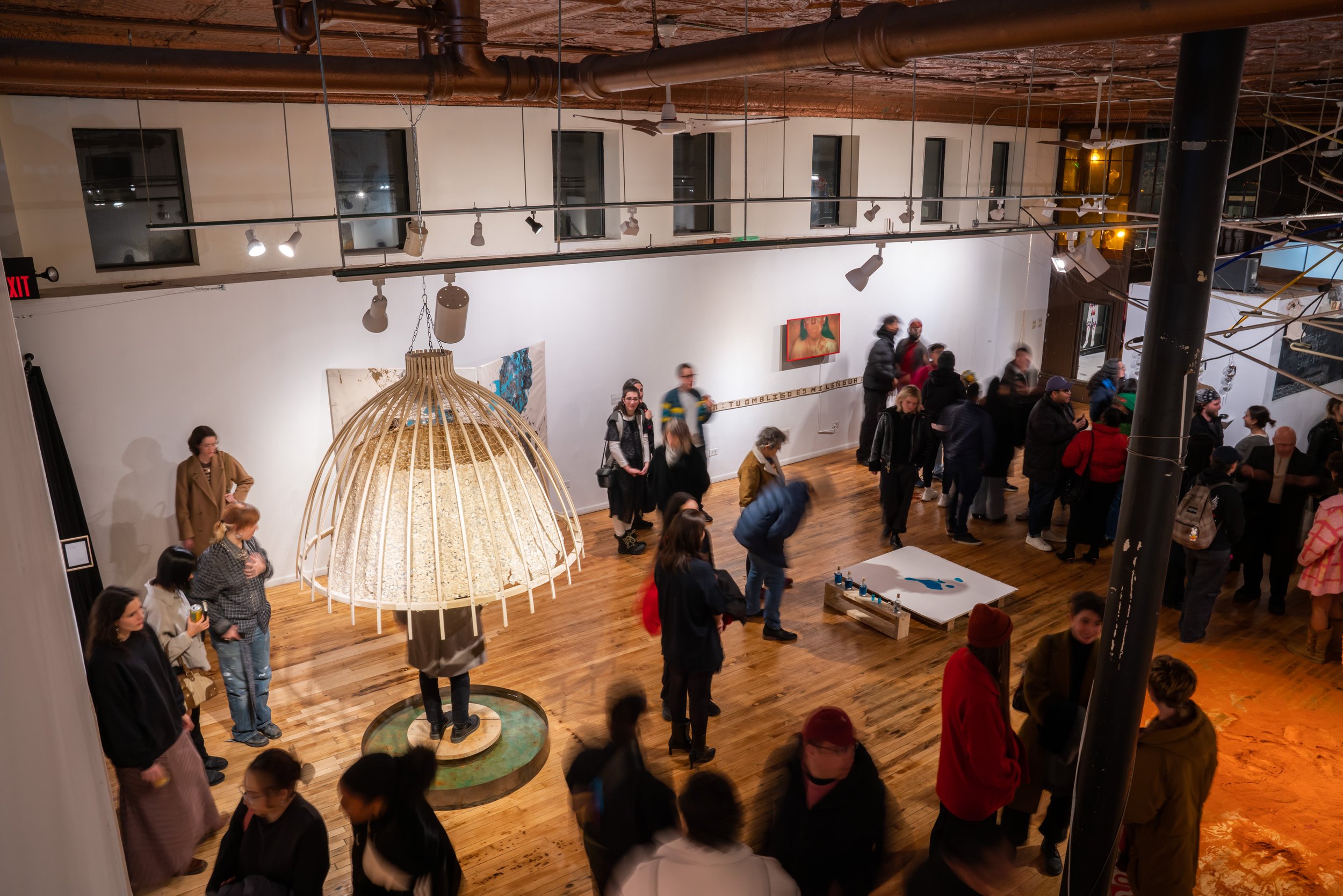
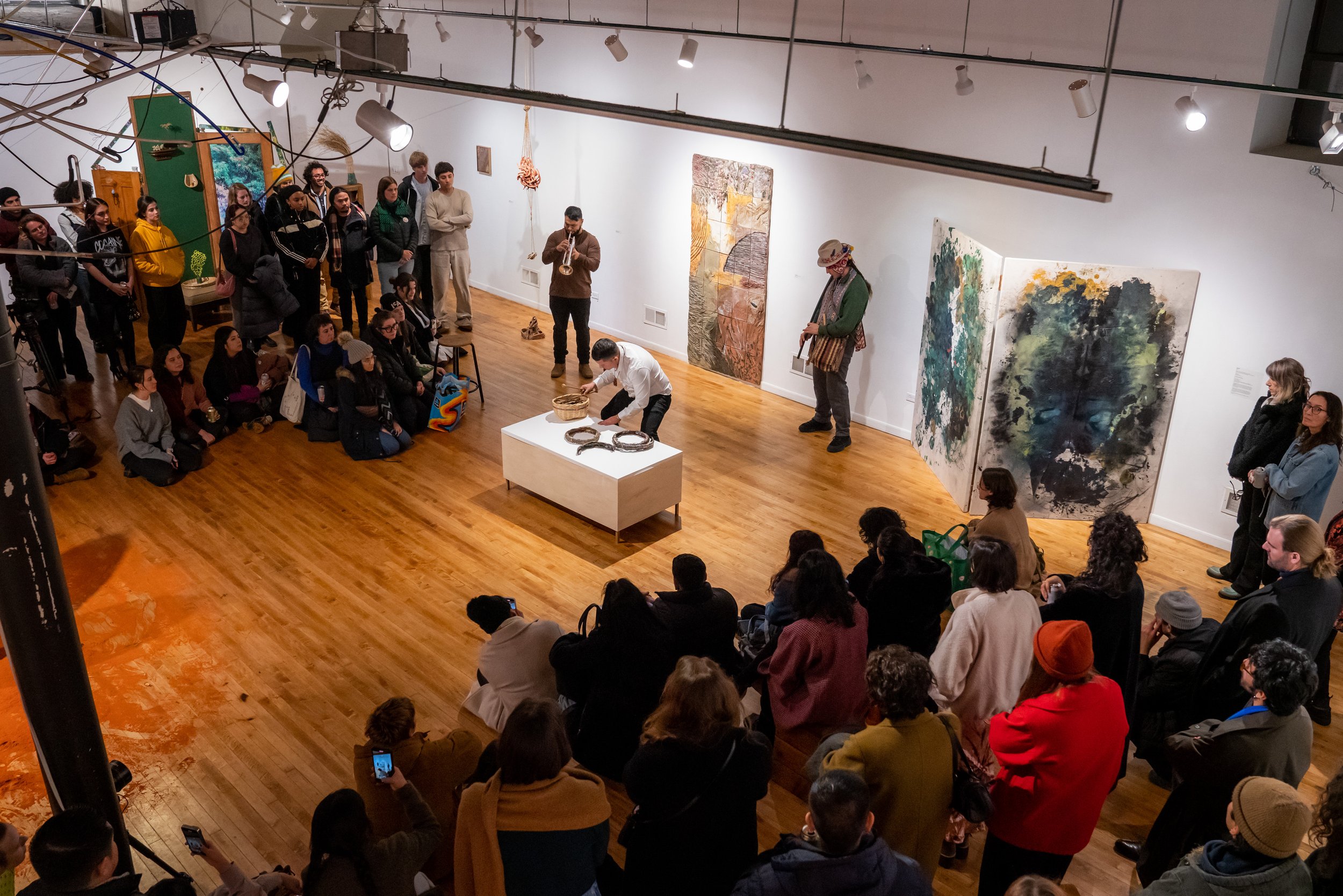
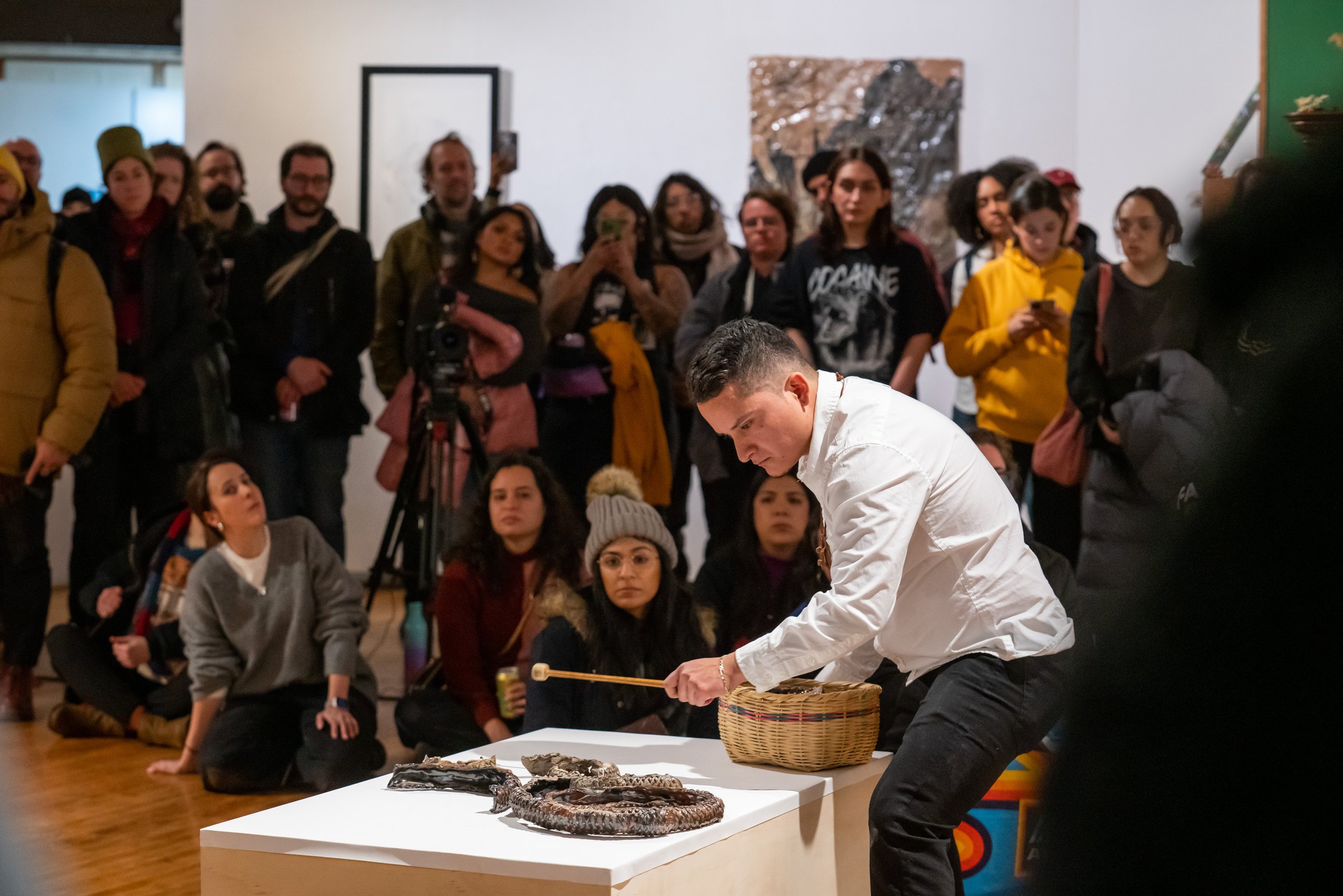
Entre ritos y portales Final Activations & Closing Reception
Collective tour by the artists and curator: January 15, 7pm
Closing reception & performances: January 17, 6-9pm
Performances:
Alden Burkes and Kushala Vora, 35 gestures towards
Kat Bawdenm, Every cell in your body has a weight an expanded cinema performance exploring memory, death, and mothering.
Veronica Anne Salinas a sound assemblage using field recordings, ambient textures, and light for an embodied sonic experience.
Entre ritos y portales
Sebastian Bruno-Harris, Gabriela Estrada, Sofía Fernández Díaz, Mariana Noreña, Frank Vega, Kushala Vora, and Irene Wa.
Curated by Sofía Gabriel in collaboration with the artists.
Entre ritos y portales (Amidst rites and portals) presents the introspective journeys, embodied experiences, and rituals of seven artists who are deepening their connection with nature and reclaiming their bond with the Earth.
By embracing ephemerality, the artists reflect on the remnants of our existence: what lingers after we are gone? They meditate on the impermanence of both art and life itself, inviting us to return to life's origins (the seed, the womb) and unlearn the systems that have disconnected us from nature and each other.
This exhibition explores the intersection of visual art and performativity, with the body at the heart of the creative process and the viewer’s experience. Whether through action, movement, or creation itself, the artists draw inspiration from the body, infusing their work with an embodied presence that evolves with every interaction.
Entre ritos y portales, nothing remains static. The works are alive, evolving over time—growing, moving, expanding, or disappearing—creating an environment for an uncertain journey.
Entre ritos y portales presenta viajes introspectivos, experiencias y rituales de siete artistas conectados con la naturaleza y reclamando un vínculo con la Tierra.
Abrazando lo efímero, los artistas reflexionan sobre nuestra existencia y cuestionan lo que persistirá una vez que hayamos desaparecido. Contemplando la impermanencia tanto del arte como de la vida, los artistas nos invitan a volver al origen. A emprender un retorno a la semilla, al vientre materno, a oponernos a los sistemas que nos han deshumanizado y desconectado de la naturaleza.
Esta exhibición explora el diálogo entre las artes visuales y la performatividad, con el cuerpo en el centro del proceso creativo y en la experiencia del público. Ya sea a través de la acción, el movimiento o la creación misma, los artistas se inspiran en el cuerpo, fundiendo su obra con una presencia encarnada que evoluciona con cada interacción.
Entre ritos y portales, nada permanece estático. Las obras están vivas, evolucionando con el tiempo: creciendo, moviéndose, expandiéndose o desapareciendo; creando un entorno para un viaje incierto.
Final Response to "Entre ritos y portales" at Co-Pro
Essay by Nicky Ni
I came to Entre ritos y portales on a sunny Saturday afternoon, jet-lagged. It had stopped snowing. I tried to stump the wetness off my shoes as I swung the door open, finding not a soul inside. The sun gleamed on the reflective surfaces of the sculptures near the windows: clayware, glass, metal. A musky, warm smell imbued the stillness, the kind of welcoming serenity found in a temple.
The show is eventful at every sight level. Some pieces blossom ankle-high, while others are suspended from the ceiling. Mariana Noreña G’s horizontal line on the ground, made of quinoa seeds, ash, and coil, that stretches across the entrance—as though demarcating a beginning—has dissipated, leaving only the label stubbornly stuck to the wall. Next to it, Gabriela Estrada performs through a video titled God Has a Mother (2024). The artist, whose bust is cropped just beneath her eyes by the camera frame, is covered with red clay. She speaks about mothers and daughters, vigorously, passionately; she chants female vitality and resilience into an incantation as she shovels handfuls of clay into her mouth and chews on them with rigor.
Further down, Noreña’s other piece The House That Lives Within Me (2023) opens up like a parasol in mid-air, a human-size lampshade that hovers over a round, elevated island concentric to the larger basin within which it sits. To activate this piece is to stand on the island that can only hold one pair of feet and observe around: looking up, lit by natural light, is the dazzling inner shade made of pulped corn husks; down below, water from Lake Michigan has etched the bottom and sides of the steel basin with turquoise, cyan, and ochre.
Other suspended objects are a lot more sensitive, in a way as though they knew they were hanging and swinging. Irene Wa.’s Flower crate (2024) by the entrance, like a halved cacao fruit bleeding in raspberry red, undulates to the small current of air I have brought inside. It responds to my presence.
Sofía Fernández Diáz’s monumental installation Umbral (2024) transforms the enclosed low-ceiling nook beneath the mezzanine level into an altar. Two rows of long strips of ink-steeped paper, earthy, streaky, each about a foot wide, hang from the ceiling, angled perpendicular to the side of the wall. The paper is coated with beeswax. Its dizzying smell punctures the space—a pungent scent of protection. I wasn’t sure what the beaded wood stick that hung from the wall at the end of this pathway signified, nor could I unravel the riddles about those individual red beans, like little offerings, cradled by minuscule baskets pinned to the wall, but they brought me curious bits of delight.
“The works are alive, evolving over time—growing, moving, expanding, or disappearing—creating an environment for an uncertain journey,” curator Sofía Gabriel states in the opening text. This statement is most apt for Diáz’s Azul (2024), which has a whole universe spilled over a large piece of watercolor paper laid out on a low platform. A row of dainty jars and small bottles contain electric-blue ink of various shades are conjured from oxidized copper. At the opening, and perhaps throughout the show, whatever has been poured and layered on top of the paper has now formed a geography of wonder. Mounds of crystals have accumulated, like mushroom clouds frozen in time; puddles of liquids have turned into salty lakes, their mesmerizing abyssal blue dotted by crystallizing whitecaps.
This azure and cerulean converse with the energetic splashes of paint on Frank Vega’s vertical canvases hinged together to stand like a folding screen. This “screen” is part of a pair with one on each side of the gallery. In front of the other set, a small low table displays what looks like ceramic snakeskin fragments. They bear the same scaly patterns as that which has been impressed into the painted surface—as though they slithered across the canvas. But they are much thicker than skin, seeming almost armature-like where they are layered. These pieces, some only partially glazed with the colors of molasses and coffee, fill a woven basket in the corner of the table and lay loose on the tabletop. Three ouroboros have been disrupted by a pair of mallets. I imagine how Frank used the mallets to break the circles, shattering eternity into small pieces.
Fragmentation is celebrated in this show. It sprawls symmetrically like a skeletal Rorschach inkblot in Irene Wa.’s wall-based The Remains (2024). It is also sweetly hinted at in Kushala Vora’s Everything carries me to you (2024), a tiled ceramic relief that is expressive and attentive to details like one of Ruth Duckworth’s. The seam between two tiles cuts right through a hand, separating the reach from its intention. The assemblage made by Sebastian Bruno-Harris, titled Bracket Axon Salad Knots (2024), is a deconstructed cabinet of curiosity that unfolds into myriad fragmented memory objects: vines and vessels, a newel post, easels and ladders, hooks and sconces—they are the ornaments of gravity, the temptations of precarity. One small photograph, discretely attached to a door, shows a tunnel where stalactites have grown from the ceiling. The cave formations would be an appropriate metaphor for Entre ritos y portales, a collection of works that exemplify the work of time by showcasing process, growth, decay, and the love and respect the artists all share for the materials they use and see as sacred.
